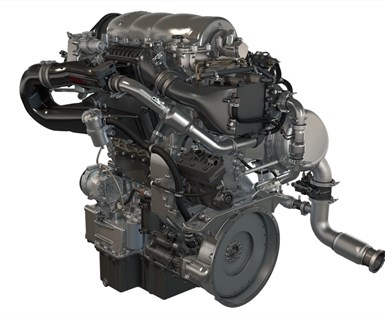Opposed-Piston Engine Developer Touts 2027 Diesel Emissions Capabilities
Achates moves closer to production, starting with commercial vehicles
“At a time when the industry is contemplating many technology options to address clean energy, it’s important to have pragmatic solutions in the conversation that can have more immediate impact, and meeting or beating the most stringent regulations with less cost and complexity and no reliance on enabling infrastructure is compelling,” asserts David Crompton, president and CEO of San Diego-based Achates Power.
The Engine

Achates 3-cylinder 10.6-liter diesel (Image: Achates)
In this case, the pragmatic solution Crompton is referring to is Achates’ opposed-piston engine, which promises to meet more stringent emissions requirements with current aftertreatment systems—and without having to switch to electrified drivetrains.
The Tests
Crompton is celebrating recent tests that showed Achates’ 3-cylinder 10.6-liter opposed-piston diesel engine complies with pending 2027 emissions requirements.
The Results
In the tests, which were conducted in San Diego and Detroit, the heavy-duty diesel mill measured:
- 0.02 grams per brake hp-hour of nitrogen oxide emissions, meeting 2027 California requirements that cut NOx levels by 90%
- 422 g of carbon dioxide, which is 8% below the current U.S. Environmental Protection Agency standard of 460 g CO2 and 2% under 2027 targets
Why It Matters
The results were achieved with a conventional exhaust fluid injection aftertreatment system, which Achates boasts is more efficient, cheaper and less complex than conventional engines and aftertreatment approaches.
What’s Next?
Achates has been developing the technology, which eliminates the cylinder head and valve train, since 2004. (Others have been at it since the 1930s.)
The tests results are another step in the validation and commercialization processes.
In addition to commercial vehicles, Achates is working on applications for passenger cars, military vehicles and stationary applications.
RELATED CONTENT
-
GM Develops a New Electrical Platform
GM engineers create a better electrical architecture that can handle the ever-increasing needs of vehicle systems
-
on lots of electric trucks. . .Grand Highlander. . .atomically analyzing additive. . .geometric designs. . .Dodge Hornet. . .
EVs slowdown. . .Ram’s latest in electricity. . .the Grand Highlander is. . .additive at the atomic level. . .advanced—and retro—designs. . .the Dodge Hornet. . .Rimac in reverse. . .
-
Plastics: The Tortoise and the Hare
Plastic may not be in the news as much as some automotive materials these days, but its gram-by-gram assimilation could accelerate dramatically.








